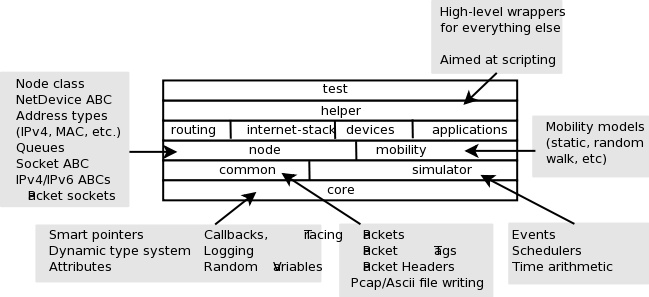
| [ < ] | [ > ] | [ << ] | [ Up ] | [ >> ] | [Top] | [Contents] | [Index] | [ ? ] |
This manual is organized into several parts with several chapters per part. This chapter describes the overall software organization and the corresponding organization of this manual.
ns-3 is a discrete-event network simulator in which the simulation core and models are implemented in C++. ns-3 is built as a library which may be statically or dynamically linked to a C++ main program that defines the simulation topology and starts the simulator. ns-3 also exports nearly all of its API to Python, allowing Python programs to import an "ns3" module in much the same way as in C++.
Figure 1.1: Software organization of ns-3
The source code for ns-3 is mostly organized in the src/
directory and can be described by the diagram in fig:organization.
We will work our way from the bottom up; in general, modules
only have dependencies on modules beneath them in the figure.
We first describe Part 1 of the manual.
The simulation core is implemented in src/core, and the core is
used to build the simulation engine src/simulator. Packets are
fundamental objects in a network simulator and are implemented in
src/packet. These three simulation modules by themselves
are intended to comprise a generic simulation core that can be used
by different kinds of networks, not just Internet-based networks.
The above modules of ns-3 are independent of specific network and
device models, which are covered in later parts of this manual.
In addition to the above ns-3 core, we describe also in Part 1 two other modules that supplement the core C++-based API. ns-3 programs may access all of the API directly or may make use of a so-called “helper API” that provides convenient wrappers or encapsulation of low-level API calls. The fact that ns-3 programs can be written to two APIs (or a combination thereof) is a fundamental aspect of the simulator and is also covered in Part 1. We also describe how Python is supported in ns-3 as the last chapter of Part 1.
The remainder of the manual is focused on documenting the models
and supporting capabilities. Part 2 focuses on two fundamental
objects in ns-3: the Node and NetDevice. Two
special NetDevice types are designed to support network emulation
use cases, and emulation is described in Part 3.
Part 4 is devoted to Internet-related models, including the sockets
API used by Internet applications. Part 5 covers applications, and
Part 6 describes additional support for simulation, such as animators.
The project maintains a separate manual devoted to testing and validation of ns-3 code (see the ns-3 Testing and Validation manual).
| [ < ] | [ > ] | [ << ] | [ Up ] | [ >> ] |
This document was generated on August 20, 2010 using texi2html 1.82.